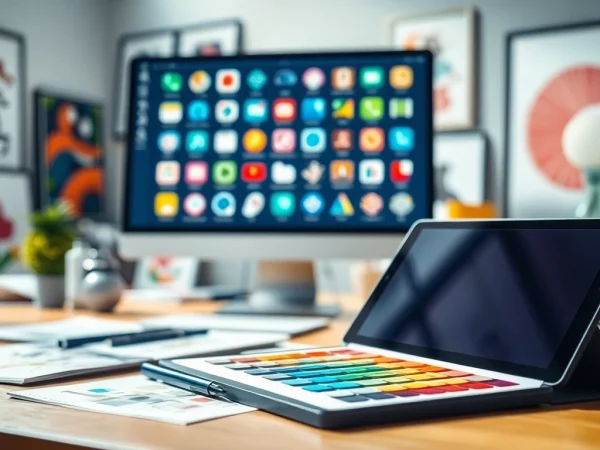Creating Impactful Icons for Your Projects: Design Tips and Best Practices
Understanding Icons and Their Importance
Icons are more than just small images; they are powerful visual representations that enhance communication in digital design. As we dive into the world of icons, we will explore their definition, historical evolution, and the vital role they play in user experience.
Defining Icons in Design
In design terms, an icon is a graphic symbol that represents an object, action, or concept. Icons can vary significantly in style, complexity, and function. Their primary purpose is to convey information quickly and efficiently, making it easy for users to comprehend complex messages through simple visuals. Icons can serve as navigational aids, action prompts, or visual metaphors, ultimately creating a more engaging user interface.
Historical Evolution of Icons
The history of icons dates back thousands of years. Ancient civilizations used pictographs to convey stories and information before written language was developed. Over time, as technology advanced, so did iconography. The advent of computers in the mid-20th century saw the introduction of pixel art and simple vector graphics.
In the 1980s, personal computing brought forth the graphical user interface (GUI), which introduced standardized icons like the file folder and trash can. The late 1990s and early 2000s marked the rise of web design, where icons became integral to navigation and branding. Today, with the proliferation of mobile devices and applications, icons are more crucial than ever, evolving alongside trends in minimalist and flat design.
The Role of Icons in User Experience
The significance of icons in user experience (UX) cannot be overstated. Well-designed icons can enhance usability, guiding users intuitively through an interface without the need for excessive text. For instance, universally recognized icons such as the magnifying glass for search or the gear for settings facilitate quick recognition and interaction.
Icons also assist in maintaining brand identity and aesthetic appeal, contributing to an engaging visual experience. The right icon can evoke emotions and convey brand values, making them an essential component of modern design.
Types of Icons and Their Uses
Static vs. Animated Icons
Icons come in two primary types: static and animated. Static icons are simple, non-moving graphics that serve functional purposes within an interface. They are often used for navigation, branding, or status indicators, providing immediate visual cues without distracting the user.
On the other hand, animated icons can enhance interactivity and engagement. They can draw attention to certain elements, indicate loading processes, or illustrate complex actions. For instance, a spinning loader icon signals to users that their request is being processed, providing essential feedback during waiting periods.
Icons Across Different Industries
Icons are versatile tools used across various industries, each adapting them to fit specific contexts. In finance, icons like currency symbols (dollar sign, euro symbol) and graphs serve to convey economic activities compellingly. In healthcare, icons representing medical equipment, health conditions, or patient services enhance communication, often seen in infographics and health applications.
In the tech industry, icons are not just functional but also aesthetic, incorporating elements of modern and flat design. They play a critical role in websites and apps, from app store icons to user interface features. Besides functional use, industries such as education leverage icons in infographics to aid learning and communicate complex information visually.
Best Practices for Using Icons Effectively
To maximize effectiveness, consider the following best practices when using icons:
- Consistency: Ensure uniformity in design style, weight, and color palette across all icons.
- Clarity: Choose icons that convey meaning quickly and clearly, avoiding overly complex designs that require explanation.
- Accessibility: Use icons alongside text labels, as this helps users with varying abilities understand their meaning.
- Scalability: Design icons that maintain quality at different sizes, ensuring they remain legible and effective on various devices.
Designing Your Own Icons
Choosing the Right Tools for Icon Design
Creating custom icons involves selecting the right design tools. Software options like Adobe Illustrator, Sketch, and Figma are popular among designers for their extensive capabilities in vector graphic creation. Each software has unique features; for example, Figma is excellent for collaboration, while Illustrator excels in vector manipulation.
Additionally, there are online tools like Canva and Vectr, which cater more to beginners looking to create simple icons quickly. Choosing a tool depends on the designer’s skill level, project requirements, and team collaboration needs.
Color Schemes and Style Guidelines
The color scheme significantly impacts how icons are perceived. Different colors convey distinct meanings and emotions; blue often represents trust, while green symbolizes growth. When designing icons, make sure to align the color scheme with the overall branding and user interface aesthetics.
Style guidelines are also essential. Decide whether the icons will be flat, outlined, 3D, or filled, and maintain a consistent style throughout your design. Adhering to these guidelines not only creates a cohesive look but also enhances comprehension as users develop familiarity with the design language.
Testing Icon Usability with Users
Once icons are designed, usability testing is vital to ensure they effectively communicate their intended messages. Conduct user testing sessions to gather feedback on icon recognition and interpretation. You can use A/B testing to compare which icons resonate better with users and improve based on their input.
Methods such as card sorting can also help determine if users associate the icons with the correct functions. Continuous feedback loops enable designers to refine their creations, ultimately improving the user experience.
Resources for Finding Quality Icons
Free vs. Paid Icon Resources
Numerous resources are available for sourcing icons, both free and paid. Free resources like Flaticon and Icons8 offer extensive libraries of icons spanning various styles and categories. These platforms typically provide icons in multiple formats (SVG, PNG, etc.), making them accessible for various design needs.
On the other hand, premium resources like Noun Project and Iconfinder might charge a fee for high-quality, unique icons. Paid resources often come with extensive customization rights and guarantees for quality, making them a worthwhile investment for commercial projects.
Evaluating Icon Quality and Relevance
To ensure icon quality and relevance, pay attention to several factors:
- Resolution: Check if the icons are available in high-resolution formats and multiple sizes.
- Licensing: Always verify the licensing agreements. Some icons might be free for personal use but require attribution or a fee for commercial applications.
- Feedback and Rating: Explore user ratings and reviews on icon resources to gauge their quality and effectiveness before implementation.
Top Websites for Downloading Icons
Here are some top websites where you can find a wealth of high-quality icons:
- Flaticon – Offers millions of free icons in various formats.
- Icons8 – Combines static and animated icons, ideal for web and mobile applications.
- Noun Project – Features a vast library of icons, allowing for easy searches and downloads.
- Iconfinder – A marketplace for both free and premium icons.
- Freepik – Provides free vectors, including icons, that can be edited easily.
Future Trends in Icon Design
Emerging Styles and Innovations in Icons
As design trends evolve, so do icons. Emerging styles such as minimalism and flat design continue to gain traction, emphasizing simplicity and clean lines. Additionally, 3D icons and immersive designs are on the rise, enabled by advancements in technology and design tools.
Icons are also becoming more dynamic, with increased use of animation to promote engagement. Micro-interactions, such as subtle icon animations triggered by user actions, can create delightful moments and enhance the overall user experience.
The Impact of Technology on Iconography
With the rapid advancement of technology, the way icons are created and implemented is changing dramatically. Tools harnessing artificial intelligence (AI) can now assist in the design process, offering suggestions based on existing designs or automating repetitive tasks, making icon creation more efficient.
Furthermore, new formats such as SVG allow for scalable graphics that adapt across devices and resolutions seamlessly, ensuring that icons maintain their clarity regardless of screen size. This adaptability is particularly crucial in today’s multi-device environment.
Preparing Icons for the Next Generation of Digital Design
As we look to the future, being proactive in icon design will be crucial. Designers must stay updated on emerging trends, user preferences, and technological advancements to create icons that not only meet current demands but also anticipate future needs.
Additionally, encouraging a streamlined workflow by incorporating flexible design systems can improve efficiency and consistency across projects. Collaborative tools that facilitate real-time feedback and iteration will also empower teams to innovate continuously.










